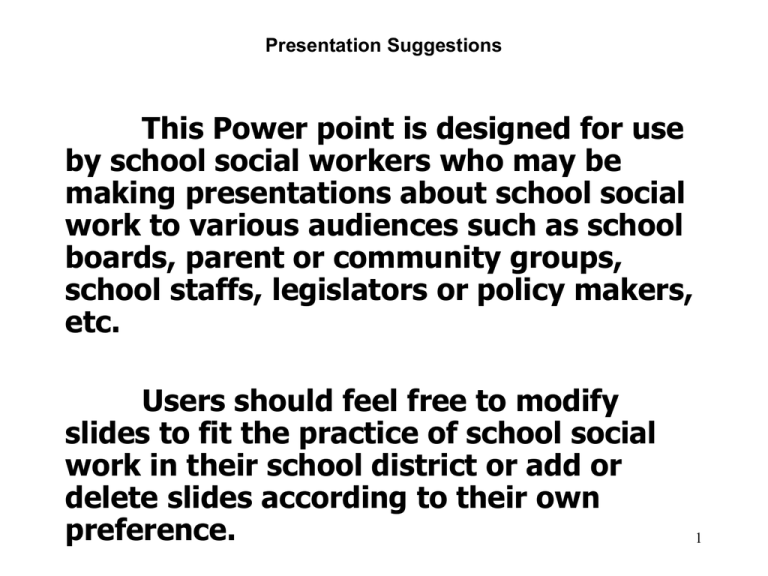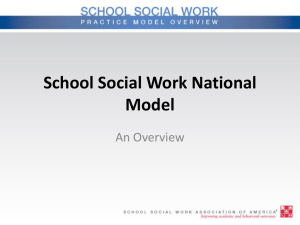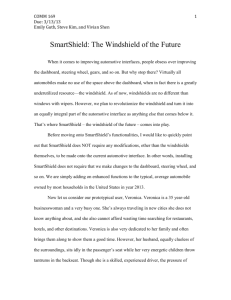Promoting School Social Work Presentation Template
advertisement

Presentation Suggestions This Power point is designed for use by school social workers who may be making presentations about school social work to various audiences such as school boards, parent or community groups, school staffs, legislators or policy makers, etc. Users should feel free to modify slides to fit the practice of school social work in their school district or add or delete slides according to their own preference. 1 The California Association of School Social Workers in cooperation with the The School Social Work Association of America present 2 California School Social Workers Develop Successful Students and Engaged Families and Communities with our Public Schools 3 ALL CHILDREN • Want to learn and succeed in school! • Have families that want them to succeed in school and in life! 4 YET MANY FAIL In 2002 only 32 percent of fourthgraders could read skillfully at grade level as measured by the National Assessment of Educational Programs • (United States Department of Education, 2004). 5 BECAUSE OF BARRIERS TO LEARNING 40% of American children are at risk for school failure due to poverty, race, immigration, poor English language skills, living in a single-parent family, parents with little education or health problems (National Commission on Children, 1991) 6 EMOTIONAL BARRIERS About 19% of all children seen by Primary Care Physicians have behavioral and emotional problems. 1 in 5 have a diagnosable mental, emotional, or behavioral disorder. 7 BUT FEW RECEIVE HELP… • Fewer than 1 in 5 of the 17.5 million children needing mental health services actually receive them. (Report of the Surgeon General’s Conference on Children’s Mental Health, 11/8/01) 8 ECONOMIC BARRIERS • One in five children under five years old, living in the US in 2003 lived in poverty One in 10 American families in the US in 2003 lived in poverty (US Census, 2003) 9 ONE TEACHER SAID, “I cannot teach the head when the heart is broken or the mind is troubled” Parkway School District Missouri Teacher of the Year 10 TEACHERS CAN’T DO IT ALONE! “No teacher having a problem with a student should feel responsible for solving it alone.” Smith Mills Elementary School Henderson County, Kentucky 11 SCHOOL SOCIAL WORKERS Help teachers, students & families overcome barriers to learning. California School Social Workers 12 A RESOURCE FOR STUDENTS IN SCHOOLS School social workers are mental health professionals licensed to provide services that promote social, emotional and behavioral adjustment in school and in society. 13 SCHOOL SOCIAL WORKERS HELP STUDENTS DEVELOP INTERNAL ASSETS Individual and group counseling to develop: • positive social skills • anger management • improved self concept • self advocacy • time management & study skills • stress management skills 14 School Social Workers Help Students • Facilitate activities that increase: • the motivation to learn • attachment to school • community involvement • mental and physical health 15 DEVELOPING EMOTIONAL COMPETENCE • Jason is a 15-year-old boy in a special education class. His skills have improved and he could return to the regular class. But Jason is overweight and embarrassed. He has anxiety attacks when he is around other students because he thinks they are making fun of him. • The school social worker teaches Jason how to relax when he gets nervous. She also planned a service learning project for Jason and invited several students from the regular class to join him. With her help Jason started making friends. When they completed the project he returned to his regular class. 16 SUPPORTING TEACHERS • Providing information about the mental health needs of students • Showing how poverty, race, language or disabilities affect learning • Helping build partnerships between teachers and parents • Listening to their concerns • Supporting their effort 17 SUPPORTING TEACHERS • Sue Sweet, a second grade teacher, privately tells the school social worker in her building that she is afraid to talk to the Principal about problems with students because she thinks that he doesn’t like her. • The social worker helps Sue to look at how the principal interacts with other people. Sue realizes that the principal has a way of being sarcastic with people, even people that he likes. After her talk with the school social worker Sue feels more comfortable sharing her concerns with the Principal. 18 HELPING FAMILIES BUILD ASSETS Connecting students and families with community support services Listening to family concerns Responding to crisis Providing parent education programs Showing families ways to support their child’s learning 19 HELPING FAMILIES BUILD ASSETS • Bridging the gap between schools and culturally diverse families • Empowering families to be advocates for themselves and their child • Bringing families together to support one another 20 BUILDING UNDERSTANDING • Mr. and Mrs. Culpepper didn’t listen when Veronica’s kindergarten teacher recommended a special program, just as they hadn’t listened when school staff told them that Veronica wasn’t ready to start kindergarten. • The principal sent the school social worker to tell Veronica’s parents that she needed extra help. The school social worker didn’t start by telling Mr. and Mrs. Culpepper anything. She started by listening to Mr. and Mrs. Culpepper instead! • Over the next year the social worker continued to talk to Veronica’s parents and her teacher. With her help, they began to understand and respect each other. Her parents decided to accept some of the school’s recommendations. Her teacher began to ask her parents for suggestions about ways to help her learn. 21 BUILDING SCHOOL CAPACITY TO: • Use research based approaches that prevent problem behavior and create a safe and supportive school climate • Implement culturally competent policies and practices • Engage families as partners in the student’s education program • Connect with community service providers • Create a safe and healthy environment22 HELPING SCHOOLS SUCCEED The number of students with problem behaviors has gone down since Washington Elementary began implementing school-wide positive behavior supports three years ago. The principal recognized Washington’s school social worker, Tom Benson, for his leadership on the PBS Team. The principal said that Tom’s enthusiasm and commitment helped the staff overcome problems to make the school-wide effort work! 23 MANY PATHS TO SUCCESS! SCHOOL SOCIAL WORKERS Assisting Parents & Teachers Reducing Absences & Dropouts Improving Student Behavior Crisis Intervention Counseling & Mental Health Interventions Bullying Prevention Conflict Resolution & Anger Management Helping Students Learn Social Skills Accessing Community Resources 24 FUNDING SCHOOL SOCIAL WORK School social work positions are funded with: • Individuals with Disabilities Education Act (IDEA) • Safe and Drug Free Schools Grants • Federal at-risk funds • Medicaid Reimbursement • Other state and federal programs/grants • Individual school and/or school district budgets 25 THANK YOU • For supporting school social workers in your public schools! Together we can do great things! 26 CONTRIBUTORS • The California Association of School Social Workers (www.cassw.net) • The National Association of Social Workers California Chapter, School Social Work Council (www.naswca.org) • The School Social Work Association of America (www.sswaa.org) 27 THE VITAL LINK • School social workers link home, school & community to enhance student success 28 Pupil Services Resources • UCLA / School Mental Health Project (Espanol) • • • • Center for Mental Health in Schools Department of Psychology University of California, Los Angeles Linda Taylor and Howard S. Adelman, Co-Directors Write: Center for Mental Health in Schools, Box 951563 Los Angeles, CA 90095-1563 Phone: (310) 825-3634 Toll Free: (866) 846-4843 Fax: (310) 206-8716 Email: smhp@ucla.edu Website: http://smhp.psych.ucla.edu Center for Effective Collaboration and Practice (CECP) Website: http://cecp.air.org Mental Health Education Integration Consortium (MHEDIC) Website: http://www.units.muohio.edu/csbmhp/mhedic/index.html National Alliance of Pupil Services Organizations (NAPSO) Website: www.napso.org National Alliance for the Mentally Ill (Espanol) booklet “Parents and Teachers as Allies” Website: www.nami.org Phone: (703) 524-7600 29 Pupil Services Resources • Council for Children with Behavior Disorders (CCBD) Website: http://www.ccbd.net • Center for School Mental Health Analysis and Action University of Maryland School of Medicine Website: http://csmha.umaryland.edu • National Institute of Mental Health (Espanol) Website: http://www.nimh.nih.gov • National Dissemination Center for Children with Disabilities Website: http://www.nichcy.org (Espanol) • National Assembly on School-Based Health Care Website: http://www.nasbhc.org • Research and Training Center on Family Support and Children’s Mental Health Portland State University, Portland, Oregon Website: http://www.rtc.pdx.edu 30 CA Pupil Services Organizations: • California School Nurses Organization (CSNO) – • California Association of School Psychologist (CASP) – • • • http://www.casponline.org California Association of School Social Workers (CASSW) – • http://www.csno.org http://www.cassw.net California Association of Resource Specialist and Special Education Teachers (www.carsplus.org) California Association of Pupil Personnel Administrators California Association of Supervisors of Child Welfare and Attendance (www.cascwa.org) • California Speech-Language-Hearing Association (www.csha.org) National School Social Work Organizations School Social Work Association of America (SSWAA) (www.sswaa.org) National Association of Social Workers (NASW) (www.nasw.org) 31









